- Lake County News reports
- Posted On
Soper Reese Community Theatre launches fundraiser for new fa


The winner of the competition will represent California’s 1st Congressional District in the U.S. Capitol, where his or her artwork will be displayed for one year.
“These six young men and women are extremely talented artists with bright futures,” said Thompson. “I think it’s important to recognize and encourage young artists. The Congressional Art Competition gives our community the opportunity to do that.”
The finalists include Katelynn Meade-Malley from Lower Lake High School; Mira Weidman from Northcoast Preparatory and Performing Arts Academy in Arcata; Joshua Lobue from Fort Bragg High School; Nilla Marie Mercado from American Canyon High School; Erika Quezada from Cloverdale High School; and Nick Christen from Woodland High School.
To honor the achievement of this year’s finalists, Thompson hosted a reception for the students, their families, and local artists and residents at his Napa district office on Friday, May 6.
Since 1982, the Congressional Art Competition has given Members of Congress the opportunity to encourage the artistic talents of their young constituents.
The annual competition showcases the artistic talents and abilities of students in all 50 states, the District of Columbia, and the U.S. Territories.
The winner and a guest will be flown to Washington, D.C. to attend an awards ceremony in June.
Follow Lake County News on Twitter at http://twitter.com/LakeCoNews , on Facebook at http://www.facebook.com/pages/Lake-County-News/143156775604?ref=mf and on YouTube at http://www.youtube.com/user/LakeCoNews .
This third annual competition exclusively showcases wines that specifically state a Lake County AVA on the label.
The competition will commence at Brassfield Estate Winery in Clearlake Oaks, where a prestigious panel of wine experts from across the country will blind-taste and judge more than 300 wines to select the top finalists in each category.
Ray Johnson, director Sonoma State University’s Wine Business Institute, assistant director of the San Francisco Chronicle Wine Competition, and author of numerous articles and his blog TasteWine will preside as director for the professional judging.
Participating wineries are asked to submit their entries by the July 15 deadline.
Entry forms will be sent out early in the month of May – look to receive your competition packet soon.
All Lake County wines made in and outside the county using at least 75 percent Lake County grapes are encouraged to enter.
For more information on entry parameters, call 707-355-2762 or go to www.lakecountywineries.org .
Following the professional judging, the People’s Choice Wine Competition, a consumer tasting event will be held at Langtry Estate & Vineyards in Middletown, on Nov. 5, from 1 p.m. to 5 p.m., where the “people” will taste and vote for their choice among the judges’ top picks.
Winners of the People’s Choice Wine Awards will be announced at the conclusion of the event. For more information go to the association's Web site.
Formed in 2007, the Lake County Winery Association is a nonprofit organization of vintners and associate members.
Partnering with several other organizations, the association strives to promote the county’s unique and distinct rural attributes.
Several wine events are scheduled throughout 2011: the Lake County Wine Adventure on July 30 and 31; the Lake County Wine Auction on Sept. 17 at Ceago; the Steele Wines Harvest Faire on Oct. 8 and 9; and the People’s Choice Wine Awards tasting on Nov. 5.
For more information on upcoming events and Lake County wine news visit www.lakecountywineries.org .
Follow Lake County News on Twitter at http://twitter.com/LakeCoNews, on Facebook at http://www.facebook.com/pages/Lake-County-News/143156775604?ref=mf and on YouTube at http://www.youtube.com/user/LakeCoNews.
COBB, Calif. – A 3.3-magnitude earthquake was reported near The Geysers geothermal steamfield on Monday morning.
The quake occurred at 7:36 a.m. two miles east of The Geysers, four miles southwest of Cobb and five miles west northwest of Anderson Springs at a depth of 2.5 miles, according to the US Geological Survey.
The survey received shake reports from Calistoga, Oakland, Geyserville, Healdsburg and Roseville.
The Geysers area was hit by a 3.9-magnitude quake on April 26, as Lake County News has reported.
E-mail Elizabeth Larson at This email address is being protected from spambots. You need JavaScript enabled to view it. . Follow Lake County News on Twitter at http://twitter.com/LakeCoNews , on Facebook at http://www.facebook.com/pages/Lake-County-News/143156775604?ref=mf and on YouTube at http://www.youtube.com/user/LakeCoNews .
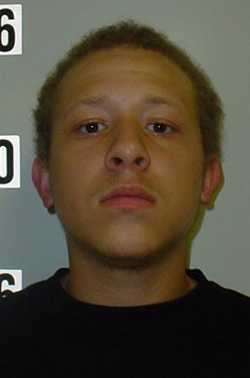
THIS STORY HAS BEEN UPDATED WITH THE MAKE AND MODEL OF THE VEHICLE THAT WAS ALLEGED TO HAVE BEEN INVOLVED.
CLEARLAKE, Calif. – Two people have been arrested in connection with a Saturday night drive-by shooting that wounded a Clearlake man.
Jerry Lee King, 18, a student from Sacramento, and a 13-year-old male were taken into custody following the incident, police said.
A Sunday afternoon report from Sgt. Tim Hobbs of the Clearlake Police Department said that at about 10 p.m. Saturday officers were dispatched to a residence on Walnut Avenue on the report of a shooting.
Hobbs said that outside the residence officers found 32-year-old Marvin Turl, who was suffering from a single gunshot wound.
He said Lake County Fire Department medical personal who had been staged at the scene treated Turl – who had sustained life threatening injuries – before he subsequently was flown by helicopter to Santa Rosa Memorial Hospital.
On Sunday afternoon Turl was said to be in stable condition, Hobbs said.
During the late-night investigation police discovered that King – accompanied by two male juveniles – allegedly drove a vehicle to Turl’s residence to confront Turl and his wife regarding an incident earlier in the day, Hobbs said.
Once at the Turls' residence, King is alleged to have fired a .380-caliber handgun at Marvin Turl several times, striking him once, according to Hobbs.
Hobbs said King and the two juveniles then allegedly fled in the vehicle, which radio reports had described as a white four-door car.
At 12:30 a.m. Sunday Clearlake Police officers, with the assistance of detectives who were called in to assist with the investigation, located King at an apartment in Clearlake, Hobbs said.
King was arrested for attempted murder, along with felony charges of conspiracy to commit a crime and discharging a firearm from a vehicle at a person, and misdemeanor charges of exhibiting a firearm and carrying a concealed weapon in a vehicle, according to jail records.
He was booked into the Lake County Jail shortly before 3 a.m. Sunday, with his bail set at $50,000. He remained in custody Sunday afternoon. Jail records indicated he's scheduled to be in court on Tuesday.
Hobbs said a 13-year-old male passenger in the vehicle at the time of the shooting was arrested for allegedly making criminal threats and conspiring to commit a felony.
The juvenile – whose name was not released because of his age – later was booked into the Lake County Juvenile Hall, Hobbs said.
Hobbs said police located both the vehicle – a white, four-door 1998 Dodge Intrepid – and the .380-caliber firearm that King allegedly used in the incident.
The Clearlake Police Department is asking anyone with information regarding this case to contact
Det. Alvarado or Det. Peterson at 707-994-8251.
Follow Lake County News on Twitter at http://twitter.com/LakeCoNews , on Facebook at http://www.facebook.com/pages/Lake-County-News/143156775604?ref=mf and on YouTube at http://www.youtube.com/user/LakeCoNews .
p { margin-bottom: 0.08in; }a:link { }
But the “homestead exemption” and the “homestead declaration” are two important protections every homeowner should know about.
These exemptions protect a portion of a homeowner’s equity against unsecured creditors who obtain judgment liens against the home.
These exemptions apply regardless of whether the principal residence is owned outright or in a living trust.
Let’s examine how these protections work and how much equity can be protected.
The homestead exemption applies automatically to a person’s or a family’s principal residence in California.
You can only have one principal residence. The homestead exemption protects a certain amount of equity against judicial foreclosures by judgment creditors.
Equity is the amount by which the value of your principal residence exceeds the combined value of all secured loans (typically mortgages and equity lines of credit). The homestead exemption does not apply to voluntary sales.
To apply, the declaration of homestead requires the homeowner to file a sworn and notarized declaration of homestead form with the county where the principal residence is situated.
Once filed, the declared homestead protects the same amount of equity as the homestead exemption, but this time with respect to voluntary sale of the principal residence.
The date when the declaration of homestead is filed is very important. The declaration does not pertain to judgment liens filed with the county prior to the declaration. So filing one’s declaration early when no judgment liens are imminent is prudent.
Moreover, if the homeowner buys a new home within six months, the homeowner can record a new declaration of homestead. Any equity from the sale of the first home that is used to buy the second home is also protected.
Now, how much equity is protected varies greatly depending on the homeowner(s)’s circumstances. A single homeowner generally is entitled to only $50,000, unless he or she qualifies for the $125,000 exemption.
A family unit generally is entitled to $75,000. A family unit includes a married couple, a single parent, or a dependent person and his caregiver.
The $125,000 (highest) exemption applies to homeowners who are 65 years of age and older, disabled persons, and persons between 55 and 65 years of age if their annual income does not exceed $15,000 (or $20,000 if married), but only in respect of nonvoluntary sales.
Let’s see how the homestead exemption works by example.
Consider John and Mary Smith, a hypothetical married couple who own a home.
The home is worth $300,000, and has a mortgage with an unpaid balance of $200,000; the Smiths have $100,000 of equity.
The Smiths owe $80,000 to a judgment creditor who has filed a judgment lien against their home. They qualify for the $75,000 homestead exemption amount, as they are not 65 or older and are not disabled. Thus, $25,000 of their $100,000 equity is exposed to judgment creditors.
The judgment creditor would be entitled to proceed with an auction sale. If the residence sold for $300,000, the $200,000 secured mortgage would be paid first, and the Smith’s would receive their $75,000 exemption amount. Lastly, the judgment creditor would receive the excess (up to his $80,000 lien).
Lastly, while the homestead exemption usually protects a conventional single-family home, it can also protect a temporary or mobile home such as a trailer, a mobile home or a boat.
Dennis A. Fordham, attorney (LL.M. tax studies), is a State Bar Certified Specialist in Estate Planning, Probate and Trust Law. His office is at 55 First St., Lakeport, California. Dennis can be reached by e-mail at This email address is being protected from spambots. You need JavaScript enabled to view it. or by phone at 707-263-3235.
Follow Lake County News on Twitter at http://twitter.com/LakeCoNews , on Facebook at http://www.facebook.com/pages/Lake-County-News/143156775604?ref=mf and on YouTube at http://www.youtube.com/user/LakeCoNews .
State Controller John Chiang updated his Web site April 26 with the new local government payroll information, part of an effort launched last year in the wake of salary concerns that arose in the southern California city of Bell.
The information, which covers calendar year 2009 both for elected officials and public employees, can be found at the Local Government Compensation Reporting Web site, http://lgcr.sco.ca.gov/.
The Web site shows minimum and maximum salary ranges; actual wages paid; applicable retirement formulas; contributions by the employer to the employee’s share of pension costs; contributions by the employer to the employee’s deferred compensation plan; employer payments for the employee’s health, vision and dental premium benefits; and also shows employees who hold multiple positions within a single local government.
Last October, Chiang began posting the information in four phases, beginning with wages and benefits of what his office said totaled more than 600,000 city and county employees.
That was followed in February and March by information from 1,285 special districts across the state, the Controller's Office said.
The third phase – launched last week – includes almost $357 million in payroll reported by 533 local agencies, according to the state.
The latest figures Chiang's office posted include the salary, pension benefits and other employee compensation for several hundred cemetery, electric, financing and construction, facilities, flood control and water conservation, recreation and park, and community service districts.
Chiang's office has planned the fourth and final phase – which will include any remaining special districts, such as library, mosquito abatement, conservation, air quality and airport agencies, and state employees' compensation – to be posted in June.
The newest information for Lake County shows 33 special districts. Seven of them are among the final phase that must submit information later this spring.
The state reported that 84 percent of all special districts in the third phase followed the new reporting requirements. All Lake County districts and local governments appear to be in compliance, based on a review of the list of agencies that failed to file in time. Each noncomplying agency could face a penalty of $5,000.
The site is updated weekly with any new information submitted, Chiang's office said.
A look at the districts
In-depth information on the special districts is available at the site, but the following is a summary of the salary ranges.
Among the districts, a small number only have unpaid board positions and no salaried employees.
Those districts include Adams Springs Water District, Butler-Keys Community Service District, Glenbrook Cemetery District, Middletown Cemetery District, Lake Transit Authority and Reclamation District No. 695.
Among the community service districts, Hidden Valley Lake Community Service District is one of the largest, serving an estimated 2,200 residences, according to district staff.
The district reports that it “provides safe drinking water that meets all State and Federal standards, maintains a sewer treatment facility that disposes wastes in an effective and efficient manner, and provides reclaimed water to the Hidden Valley Lake Golf Course.”
It has five board members, each paid up to $1,200 annually, and 12 paid employee positions, the highest being the general manager, a position currently held by Mel Aust, who receives $185,532 in compensation annually, along with $15,303 in health, dental and vision coverage, according to the data.
Clearlake Oaks County Water District has six unpaid board positions and 10 paid employees. The highest paid position is general manager, held by Darin McCosker, who received $97,327 in salary for 2009. No benefits were listed.
County Water Works District No. 1 (Lake) has five board members who received between $150 and $254 for 2009. There are six paid employees; the general manager received $82,506 and $700 in health benefits.
Callayomi County Water District has five unpaid board positions. It also has four paid positions, once again led by the general manager, who received $74,768 plus $3,265 in benefits for 2009.
Konocti County Water District's five board members receive up to $1,400 annually, and their general manager received $67,871 in salary for 2009, the highest of the district's eight paid employees, along with $8,811 in benefits.
The Cobb Area County Water District has five unpaid board members and an unpaid district secretary, with seven other paid positions. The general manager received $64,320 in salary and $22,464 in benefits.
Buckingham Park Water District has five unpaid board positions and five paid positions, ranging from $8,091 for a utility worker to $51,548 for the general manager.
There are five board members, paid up to $594 annually, in the Upper Lake County Water District, which has only two paid staff – an assistant operator, paid $30,548 with $594 in benefits, and the general manager, paid $47,203 and $5,360 in benefits.
Kelseyville Cemetery District's four board members are unpaid. It has only two paid positions, a groundskeeper that received $26,238 in pay and $1,720 in benefits, and a superintendent who was paid $46,211 in salary and $19,236 in benefits.
Lower Lake Cemetery District pays each of its board members $1,875 annually. Its four paid employees range between $17,305 for a grounds superintendent, who received $8,710 in benefits, to a sexton who was paid the same in benefits and a salary of $41,974.
Hartley Cemetery District has five unpaid board members, and three paid positions, from a maintenance assisting, paid $15,513 with no benefits, to the supervisor, paid $40,480 and receiving $22,464 in benefits.
The Upper Lake Cemetery District has five unpaid board members and three paid positions, ranging from a maintenance assistant who received $1,940 in 2009 to the supervisors, who was paid $29,582 and $1,388 in benefits.
Like most of the special district, the Redbud Healthcare District has five unpaid board members, and one paid position, a manager, who received, $23,153 and no benefits.
The Anderson Springs Community Services District has five unpaid board positions and two water operators, with salary maximums of $43,680 and $37,440, but who were paid only $14,091 and $2,288, respectively, in 2009.
Fire district data included
The county's fire districts were included in the latest data release. The districts have large numbers of paid employees, but many are part-time or seasonal.
Northshore Fire Protection District, which covers the entire Northshore area and is the largest fire district by area in California, has six board members who were paid between $350 and $965 for 2009. It has 62 other paid positions, the highest of which is the fire chief, a position held by Jim Robbins, who is paid $91,447 annually, with $7,398 in benefits.
Lake County Fire Protection District, which covers Clearlake and Lower Lake, has seven unpaid board members and 37 paid positions. Its chief, the highest-paid employee, received $102,835 in 2009 with $8,273 in benefits.
South Lake County Fire, the third-largest fire district by size in the state, has five board members who were paid between $700 and $1,200 for 2009. Among the 28 other paid positions, the highest paid was a fire engineer who was paid $22,614, with no benefits. The district contracts with Cal Fire, which covers additional salary costs.
Kelseyville Fire Protection District is led by a five-member, unpaid board. There are 49 paid positions; the highest salary paid was $87,530 to an engineer paramedic. Mike Stone, who took the chief's job later that year, didn't draw a full salary and was paid $39,071 with no benefits. No salary range was given for his position for the 2009 time period.
Lakeport Fire Protection District's five directors were paid between $1,000 and $1,200 for 2009, while among the 39 paid positions the highest salary, $84,981, was for Chief Ken Wells, who also received $18,336 in benefits. A few firefighters were paid more than Wells that year; Wells attributed those instances to payments out for a retirement and to overtime.
Lake Pillsbury Fire Protection District has five unpaid board members and 21 paid firefighter positions, ranging between $8 and $680.
E-mail Elizabeth Larson at This email address is being protected from spambots. You need JavaScript enabled to view it. . Follow Lake County News on Twitter at http://twitter.com/LakeCoNews , on Facebook at http://www.facebook.com/pages/Lake-County-News/143156775604?ref=mf and on YouTube at http://www.youtube.com/user/LakeCoNews .

LAKEPORT, Calif. – Police took a Lakeport woman into custody Saturday afternoon after she allegedly attempted to abduct a young boy from the Library Park playground.
Jacqueline Michele Shepherd, a 28-year-old student, was arrested by Officer Norm Taylor at about 1:15 p.m. Saturday, according to Lake County Jail records.
A report from Sgt. Jason Ferguson of the Lakeport Police Department said officers responded to a reported kidnapping at the park and, during the investigation, learned that Shepherd had allegedly been hanging around the children's playground where several children were playing.
He said Shepherd allegedly was observed acting suspicious and watching the children before befriending the 6-year-old.
Shepherd began pushing the child on a swing before she is alleged to have taken physical custody of the child and removed him from the playground area, Ferguson said.
Ferguson said the child's cousin reportedly confronted Shepherd, who released the boy and walked away from the area.
Some witnesses reported on Lake County News' Facebook page that the child's mother also confronted Shepherd and punched her.
Ferguson said police found Shepherd in Bigg's 155 Diner, located across the street from the park, and placed her under arrest.
He said she was booked into the Lake County Jail, with bail set at $50,000, although jail records indicated the bail amount was $30,000.
Jail records showed that Shepherd remained in custody Saturday night.
Follow Lake County News on Twitter at http://twitter.com/LakeCoNews , on Facebook at http://www.facebook.com/pages/Lake-County-News/143156775604?ref=mf and on YouTube at http://www.youtube.com/user/LakeCoNews .

LAKE COUNTY, Calif. – The investigation of a suspicious vehicle parked in a remote area off of Highway 175 near the Mendocino County line Thursday morning has resulted in one arrest for marijuana and weapons charges, and a five-hour multiagency operation to search for two additional suspects.
Arrested was 41-year-old Malaquias Parras Ramirez of Santa Rosa, according to Capt. James Bauman of the Lake County Sheriff's Office.
On May 5 at approximately 8:30 a.m. a detective sergeant with the Lake County Sheriff’s Narcotics Task Force was traveling out of county on Highway 175 when he saw a suspicious vehicle parked in a turnout approximately a mile and a half from the Mendocino County line, Bauman said.
The vehicle, a Black Toyota Camry, was occupied by two men dressed in camouflage clothing and a third man dressed in camouflage clothing was standing near the car urinating, according to Bauman.
Bauman explained that when the detective sergeant stopped to contact the men, the man standing outside of the car immediately ran and fled into the brush on foot.
He said the detective sergeant drew his duty weapon and ordered the other two men in the car to raise their hands but the driver suddenly exited the car and also fled on foot into the brush in the same direction as the other. The third man seated in the back of the car, identified as Ramirez, was detained at gunpoint and the detective sergeant requested emergency assistance on his radio.
Multiple units from the sheriff’s office and the California Highway Patrol (CHP) responded to the area to assist the detective sergeant, Bauman said. As the first backup units arrived at the scene Ramirez was taken into custody.
Sheriff’s deputies began posting themselves along the highway to try to contain the two outstanding suspects. Bauman said a search of the Toyota revealed several potted marijuana plants and a loaded handgun drawn from its holster, lying on the floorboard where Ramirez had been sitting.
Additional resources were requested to respond, including a CHP helicopter, a law enforcement K-9 team from the U.S. Forest Service, and agents from the Bureau of Land Management (BLM), Bauman said.
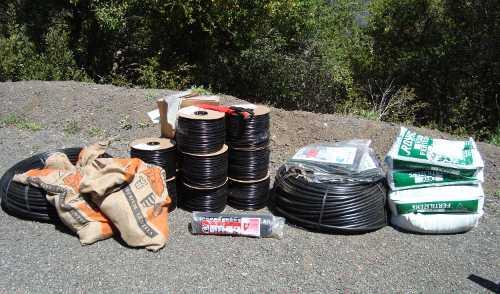
Once additional resources arrived, a ground team that included the U.S. Forest Service K-9 began tracking the mountainous area the two suspects fled into. Bauman said the K-9 led the team into a large gorge where they located a “drop site” where illegal marijuana growers had left numerous spools of drip line, bags of fittings, fertilizer and other supplies used for marijuana cultivation.
The team continued to follow fresh tracks beyond the drop site but after tracking the suspects for nearly one mile, the K-9 began to lose their scent and trail, Bauman said.
At approximately 10:30 a.m., a CHP helicopter out of Redding arrived in the area to assist with the search of the suspects. Bauman said attempts to locate and apprehend the two outstanding suspects lasted until approximately 12:00 p.m., at which time the operation was suspended. The ground team had tracked the suspects into such rugged terrain that they had to be extracted by the CHP helicopter.
Ramirez was transported to the Lake County Hill Road Correctional Facility where he was booked on charges of cultivating marijuana, transportation of marijuana, being armed in the commission of a felony and possession of a loaded firearm in public, Bauman said. He remains in the custody of the sheriff without bail due to an immigration hold.
Bauman said the Lake County Sheriff’s Office intends to seek federal prosecution of Ramirez, which could potentially result in a sentence of 10 years in federal prison for the crimes with which he is charged.
It is believed that Ramirez and the other two suspects were interrupted by the detective sergeant while they were engaged in setting up a major illegal marijuana cultivation operation, Bauman said.
He said much of the mountainous area surrounding Highway 175 that is managed by the BLM has been host to such operations in past years.
Bauman said the investigation Thursday occurred in roughly the same area as a similar incident in August 2008 when a CHP officer spotted a suspect walking into the woods after a van dropped him off on the Hopland Grade.
In that 2008 case, three Manteca men would be arrested for marijuana-related charges following a response by federal and local law enforcement, as Lake County News has reported.
Bauman said the Lake County Sheriff’s Office, BLM and the U.S. Forest Service are continuing their investigation into this and other suspected cultivation operations as “Operation Full Court Press” nears.
He said “Operation Full Court Press” is a multicounty, multiagency operation to eradicate illicit marijuana grows on federal lands.
Follow Lake County News on Twitter at http://twitter.com/LakeCoNews , on Facebook at http://www.facebook.com/pages/Lake-County-News/143156775604?ref=mf and on YouTube at http://www.youtube.com/user/LakeCoNews .
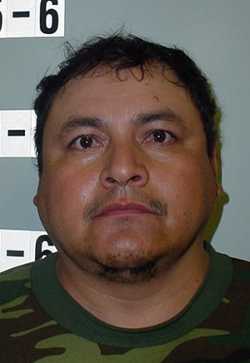
The Senate Governance and Finance Committee considered SB 286 during its meeting on Wednesday, May 4.
The bill was authored and introduced by Sen. Roderick Wright (D-Inglewood) in response to the growing concern about the loss of redevelopment agencies.
Gov. Jerry Brown has proposed eliminating funding to redevelopment agencies and enterprise zones to help address the $25 billion budget deficit.
Opponents of Brown's plan to eliminate redevelopment say it would hinder job creation and the development of affordable housing projects.
Wright's bill is meant to be an alternative to Brown's proposal.
SB 286 has been amended to include redevelopment reforms supported by the California Redevelopment Association, the League of California Cities and other members of the Protect Local Jobs and the Economy coalition.
Wright's office said the amendments would tighten the definition of blight; prohibit agencies from collecting the school share of local property tax or tax increment in new project areas starting in 2012; limit the percentage of total land area of a jurisdiction which may be included in redevelopment project areas; prohibit use of tax increment for specific purposes such as golf courses and race tracks; strengthen agency reporting and accountability requirements; and focus redevelopment activities on priorities such as job creation, cleaning up contaminated property, basic infrastructure needs and affordable housing.
At the May 4 hearing state senators from Los Angeles and San Jose as well as prominent organization spoke in favor of the bill.
They praised its ability to decrease the need to increase taxes while solving problems for more than 80 percent of California’s population, who live in underdeveloped towns.
Nevertheless, opposition on the bill's benefits centered on such matters as encouraging debt without repaying it.
There also were questions about the bill allowing local fire and police departments to lose money to redevelopment agencies. Wright asserted that fire and police departments actually would receive more funding under the bill.
The opponents didn't appear to find adequate faults with the bill because the bill addresses most of the major issues, according to Gale Connor of the California Eminent Domain Report.
Connor writes that the proposal to cut funding for redevelopment agencies arose, in part, because there are questions about redevelopment agencies’ failure to report how funding is used, and the agencies appear to have no reliable or accurate measure to prove that they are creating jobs.
SB 286 would require that redevelopment agency reporting and accountability requirements be strengthened.
At the May 4 hearing committee Chair Sen. Lois Wolk (D-Davis) left the bill on hold while it's amended.
Wolk emphasized the need to address matters including allowing redevelopment agencies to take funding from special districts.
Questions that remain include whether Wright can address these issues in a bipartisan manner and garner enough county-by-county votes.
Follow Lake County News on Twitter at http://twitter.com/LakeCoNews , on Facebook at http://www.facebook.com/pages/Lake-County-News/143156775604?ref=mf and on YouTube at http://www.youtube.com/user/LakeCoNews .
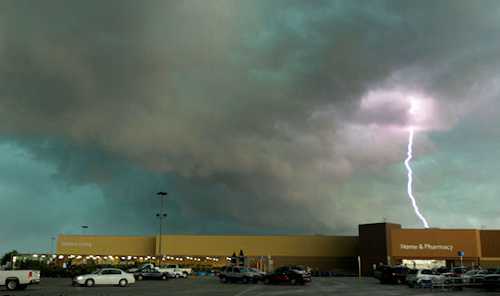
Editor's note:On Wednesday, April 27, Science@NASA writer Dauna Coulter found herself near ground zero as a super-outbreak of tornadoes ripped through north Alabama. This is the story about the science of the event she wrote and submitted from within the disaster zone.
April 27: Tornado sirens wailed all day long. They'd sound off and then wind down for a little while, only to start up again a few minutes later as forecasters spotted yet another hook echo on their radars and adrenaline-revved storm spotters confirmed the twisters that dropped from seething skies one after another.
We lined our bathroom closet with blankets and pillows for my grandson. My husband kept going outside to look at the sky. If an atmosphere can become sentient, the one out there was a malevolent, living thing. This was not your usual storm. Even our golden retriever was pacing the floor.
In the late afternoon, we lost power. We scrambled to find our radio, batteries, flashlights, candles and matches, as tornadoes continued to train across the area. The wind finally died down around 10 p.m.
April 28: The power was still out when I woke up the morning after the storm. I made coffee on our camp stove in the back yard and sat in a lawn chair to listen to the radio. The news was worse than I'd expected. As the sun rose to begin an apologetically brilliant, clear day, I said a silent prayer for those who had lost their lives in the storms. They were, and still are, on my mind and in my heart. (More than a week later, all the missing have yet to be accounted for.)
I couldn't check on family or friends by cell phone until that evening, and even then phone service was spotty, as it would be for two more days. The people I finally reached said they'd been trying to call me. Science@NASA editor Tony Phillips was among them. When we finally talked, he made sure I was OK and then said something that blew my mind: “I want you to write a story about this.”
With no lights, no computer, spotty cell phone coverage?
“OK,” I answered, and then began figuring out how to do it.
April 29: The next morning I located a friend who lived near the Tennessee border, 30 miles away, and had power and Internet. The route to her house led through one of the “war zones.” There was nothing left intact.
What had caused a storm of this magnitude?
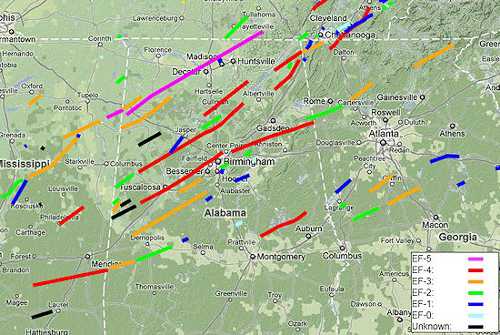
I emailed prospective interviewees at NASA and the National Weather Service, hoping they'd have Internet service – and some answers. I urged my contacts to call me as I had no computer access anywhere in Huntsville and was headed back there.
By mid-afternoon, no one had called back, so it was time to try another tack.
I drove to the National Space Science and Technology Center, a leading-edge severe weather research center housing investigators from NASA and the University of Alabama as well as the National Weather Service's Forecast Office in Huntsville.
Ironically, the historic line of tornadoes had torn through the skies right above the center on April 27, causing it to be briefly evacuated except for key weather personnel.
I was glad to see a few cars in the parking lot and hear the hum of a generator. Using my badge to enter the building, I made my way through semi-dark hallways to the Weather Service Office. There I found Larry Burgett of their Public Service Unit along with forecaster Jennifer Lee. Both of them were part of a large team that had worked from 3:30 a.m. to 10 p.m. central time, nonstop, the day of the storm to track the event and alert the public.
“It was a day unlike any other,” said Burgett. “We've never issued so many warnings in rapid succession. And we've never had so many damage reports in one day.”
The field survey team examining the damage in north Alabama reported one twister as an EF-5, a ranking reserved for the most violent and destructive tornadoes. It had peak winds of 210 miles per hour, was 1.25 miles wide in spots and stayed on the ground for 132 miles.
“Not only was there a tremendous outbreak of tornadoes – but many of them ripped along the ground for a long time,” said Lee. “It's very unusual for that many funnels to stay down that long.”
Burgett described some unbelievable sights: “Some homes were hit not once but twice – by one tornado on the heels of another. That's unheard of. Maybe in a rare case you'll hear of a home being hit twice over several years, but not in the same day. And everywhere a tornado touched down – there was major damage.”
I drove home, digesting and mourning all I'd learned that day, yet no one had explained to me how this century-class catastrophe had happened. How did this storm brew enough energy to transform itself into such a monstrous tornado-machine?
Later, NASA meteorologist Walt Petersen and UA-Huntsville meteorologist Tim Coleman called me with some facts.
“A deep cold batch of air in the central US seeped toward the southeast behind a cold front that trailed a ground-level low pressure system,” explained Petersen. “Moist air from the Gulf of Mexico streamed in toward the lower-pressure area like water heading for an open drain. Above that moist air, we had very strong winds with lots of wind shear. That means that the wind turned and sped up with height, causing the updrafts in the storm to corkscrew as they ascended into the turning wind. Collectively, those ingredients turned deadly, causing storms to form and intensify, and at the same time rotate because of the wind shear.”
Coleman added: “This kind of set up in the atmosphere is extremely rare. We have a number in meteorology called the EHI (Energy Helicity Index) that indicates the likelihood of tornadoes developing. With an EHI over 2 you can expect some tornadoes. Over 5 and you can expect some significant tornadoes. The EHI predicted by computer models the day before this event was 10, and that prediction was correct.”
Coleman admits that he was frightened by what he'd seen developing. And as part of a storm survey team sorting through the rubble the day after the mega-storm, he found that his fears had been realized.
“Brick homes were blown apart,” he said. “Even above-ground walls of their basements were gone, and there were mountains of debris – including concrete blocks and large pieces of lumber – on basement floors. Some of these tornadoes were almost unsurvivable. Only in a well-built storm shelter would you make it through.”
April 30: As time allowed over the next few days, I worked on this story outside under a shade tree in daytime and inside by candlelight at night. Though I stayed busy the rest of the time heating water to wash dishes, waiting in long lines to buy ice and gas from the few stores with generators, and checking on my elderly parents, life had, in a sense, slowed and quieted. No televisions blaring, no air conditioners humming, no weed eaters buzzing. (The extra gas was needed in cars.) Even the dogs were unusually silent. I've never slept better.
In any other circumstances, you'd think we were all enjoying an extended holiday. People were out all over town walking to the store, biking, visiting with one another. And they kept their good spirits and sense of humor through it all. One neighbor posted a sign that said, “Will trade warm beer for fire wood.”
In the evenings, our neighbors brought the contents of their defunct refrigerators and freezers over to share, and we cooked out on grills and the camp stove. Communities all over town had similar gatherings.
My 86-year-old father, who cares and cooks for my semi-invalid mother, reported each day on what their neighbors had brought them for supper. “We've been eating better than we ever did with my cooking!”" he said.
At night the city was so dark, it was like living in a different century. I rode my bike under the stars. Replacing the gaudy glare of incandescent lights, a soft glow of candlelight issued from the windows of neighbors' homes.
Some families gathered around backyard fires. And with not even a moon in view, I saw stars I'd never seen before. There above me was the whole Milky Way!
May 2: It's been a bittersweet week.
I was sitting in the back yard last night as a wave of cheering and yelling started in the distance and seemed to roll toward me. It grew louder and louder, closer and closer, building to this crescendo: my son leaning out the back door and shouting, “We have power!”
People were cheering as the lights came on swiftly, street by street, across the neighborhood.
“Let there be light!” (That was me, joining the sound wave.)
I'll remember these experiences for a long, long time: Slow, halting drives through the city with no street lights working, waiting in long lines for a ration of ice or gas or to buy a few hotdogs for the grill, curfews, taking ice cold showers, fumbling around in the darkness for my toothbrush, stubbing my toes in dim rooms … and thinking of those who were not as fortunate.
Dauna Coulter works for the National Aeronautics and Space Administration.
Follow Lake County News on Twitter at http://twitter.com/LakeCoNews , on Facebook at http://www.facebook.com/pages/Lake-County-News/143156775604?ref=mf and on YouTube at http://www.youtube.com/user/LakeCoNews .
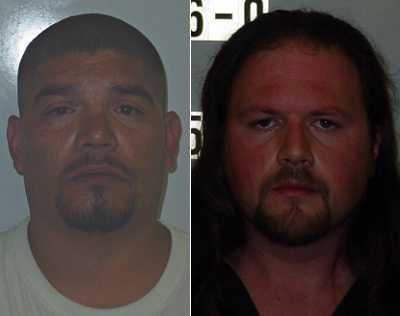
LAKEPORT, Calif. – Two Lake County men were arrested following a road rage incident Wednesday that culminated in a fight in the parking lot of a local fast food restaurant.
Damon Joe Shepherd, 29, of Lakeport and Travis Wayne Vaughn, 28, of Nice were taken into custody early Wednesday evening, according to the Lakeport Police Department.
A report from Sgt. Jason Ferguson explained that the incident began on the Nice-Lucerne Cutoff where Shepherd is alleged to have cut in front of Vaughn, nearly causing an accident.
Ferguson said that, as both drivers entered Highway 29 in the Hill Road area it was alleged that Vaughn then cut Shepherd off.
He said Shepherd followed Vaughn to the Taco Bell, located on Parallel Drive in Lakeport, and they allegedly got into a verbal confrontation in the parking lot.
Acting Lakeport Police Chief Brad Rasmussen said police received a call about the confrontation at Taco Bell at approximately 4:42 p.m.
“A Lake County Probation officer called in the incident at Taco Bell,” Rasmussen said.
Rasmussen said the probation officer saw Shepherd allegedly brandishing two knives in a threatening manner toward Vaughn before police arrived.
Lakeport Police sent two units to the scene, Rasmussen said.
After officers determined both Shepherd and Vaughn were intoxicated – each were given field sobriety tests – both men were arrested for driving while under the influence of alcohol, Ferguson said.
Shepherd was additionally charged with brandishing a weapon in a threatening manner and possession of a dangerous weapon, Ferguson said. Rasmussen added that Lakeport Police had prior contacts with Shepherd.
Ferguson said both men were taken to the Hill Road Jail where they were booked.
Shepherd's bail was set at $10,000, and he remained in custody Thursday night, according to jail records. Vaughn posted his bail, set at $1,740, and was released.
E-mail Elizabeth Larson at This email address is being protected from spambots. You need JavaScript enabled to view it. . Follow Lake County News on Twitter at http://twitter.com/LakeCoNews , on Facebook at http://www.facebook.com/pages/Lake-County-News/143156775604?ref=mf and on YouTube at http://www.youtube.com/user/LakeCoNews .

If you aren't already a subscriber, please take a moment to become one.